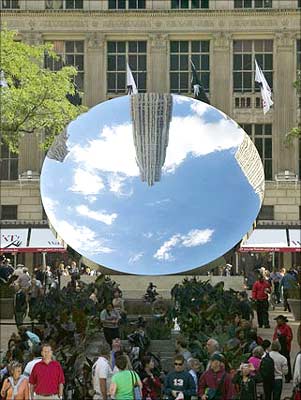Columbus day parade in NYC
 I went to New York last week and happened to be right by Rockefeller Center on Columbus Day. There was a huge parade going on of all types of New Yorkers, and I had the opportunity to look into Anish Kapoor's new monumental sculpture, Sky Mirror, while I watched the crowd and the floats.
I went to New York last week and happened to be right by Rockefeller Center on Columbus Day. There was a huge parade going on of all types of New Yorkers, and I had the opportunity to look into Anish Kapoor's new monumental sculpture, Sky Mirror, while I watched the crowd and the floats.I say look into because it wasn't at all an experience of looking at. The image you see here was taken from the other side of the mirror from where I was standing while watching the parade down 5th Avenue. (If you were standing where this photographer were standing at the time, I would have been where these tiny people whose heads are in the sun are standing.)
The text in the pamphlet that's distributed by Rockefeller Center reads: "This optical object changes through the day and night and is an example of what Kapoor describes as a 'non-object,' a sculpture that, despite its monumentality, suggests a window or void and often seems to vanish into its surroundings." It says s sculptures "recede into the distance, disappear into walls or floors, or otherwise destabilise our assumptions about the physical world." (text and photo courtesy of the New York Public Art Fund)
 Here is an image of an etching Kapoor did at Crown Point Press in 1988. I like it in relation to the Sky Mirror because to me it cconveys the same idea of the strange in-between that happens when a reflection presents a new space to the space that it's in. These little bean figures are the same shape as the giant
Here is an image of an etching Kapoor did at Crown Point Press in 1988. I like it in relation to the Sky Mirror because to me it cconveys the same idea of the strange in-between that happens when a reflection presents a new space to the space that it's in. These little bean figures are the same shape as the giant  Cloud Gate sculpture he did in Chicago's Millenium Park in 2004. In quality, though, it makes me think of Sky Mirror, because of the way it depicts two voids that somehow fill the space between them.
Cloud Gate sculpture he did in Chicago's Millenium Park in 2004. In quality, though, it makes me think of Sky Mirror, because of the way it depicts two voids that somehow fill the space between them.Anish Kapoor, Untitled (4), 1988. Color spit bite aquatint. Paper 23 x 18-1/4", image18 x 14", Edition 20. Printed by Crown Point Press.
- Rachel Lyon

1 Comments:
I like the idea that two voids can fill the space between them. Pregnant and beautifully said.
Post a Comment
<< Home